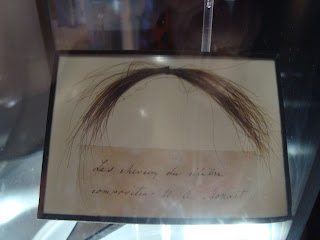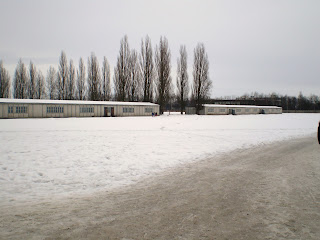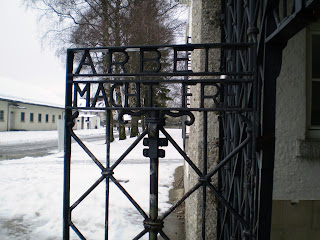Tourism plays an important role in Prague's dynamics; souvenir shops line the streets and apparently the city has a reputation that rivals Amsterdam for its hopping night-life. Maps and brochures in the hostel pointed to the nearest burlesque shows, pub crawls and night clubs. Although the party atmosphere is infectious, we did not spend any time in the clubs. We did attempt to go on a beer tour, but it was cancelled after we were the only people to show. We also tried to catch some live music, but the bar did not open till 10pm and we had arrived too early. At least we tried!
Prague is a city in which we did a lot of walking... to the point where we had to buy Garnet a new pair of shoes because he had developed a hole in one. Walking was a nice way to see the contrasts of Prague, such as the differences between its Old Town and New Town. It is amusing for a Canadian to consider Prague's "New" Town, which dates to the 14th century! Not many of the original buildings remain, but even the newer architecture is still old by North American standards. One of the main features in the New Town is the long, narrow Wenceslas Square. At night it is beautiful, with its statue of St Wencelas standing sentinel in front of the National Museum.
At the center of the Old Town is the Old Town Square, which happened to be just around the corner from Hostel Homer where we were staying. To my pleasure, the square was filled with a Czech Christmas market. In comparison to German markets there seemed to be less sweets, but a greater selection of hot foods. Here's a look at the square:
Above is the astrology tower, the main attraction in the Old Town Square. The detail on the right shows the dials on the side of the tower. If you look carefully you can see a small skeleton to the right of the upper dial. At certain times the skeleton will pull a rope to start the bell ringing which is then answered by a trumpeter at the top of the tower.
Here are pictures of the square depicting the Gothic style Tyn Church which was originally built by the Hussites, but taken over by the Roman Catholics. Interestingly, if you examine the church spires you will see that they are not symmetrical. This intentional difference represents masculine and feminine dimensions. Also, legend has it that this church inspired Walt Disney's palace. Understandable considering how gorgeous it is lit up at night.
Below are some of the goodies we discovered at the Christmas market. The cylindrical pastry is the traditional Trdelnik, a delicious roasted dough rolled in sugar. Mmmm...
An important landmark in Prague is Charles Bridge, a walking bridge which stretches across the Vltava River. The bridge was lined with street vendors and a few die-hard jazz musicians despite a bit of rain. When it was built in the 14th century is was the main access to Prague Castle from the Old Town. We learned more about how it was constructed at the Charles Bridge Museum. In the below picture, the Bridge is in the foreground, and the tall spires on the hill behind belong to the cathedral in Prague Castle.
Prague Castle was one of the highlights of our time in the city. Visitors can opt for a short or long tour, and since we were hard-core tourists we committed to the long tour which basically gives you access to everything on the grounds. At the center of the complex is St Vitus Cathedral, an example of Gothic architecture which soars above the city skyline. Many other attractions surround the Cathedral including the Old Royal Palace where you can visit throne rooms and great halls, the street entitled Golden Lane which originally housed soldiers but was used by civilians into the 1900s, St George's Basilica/Convent, the Rosenberg Palace which became an unmarried noble woman's school, the Powder Tower showcasing the Castle Guard, and the Picture Gallery exhibiting the Castle's works of art.
Here are pictures to help me explain:
The main entrance to the palace.
It was quite a challenge to take a picture of the Castle Guard because many goofy male tourists wished to pose with them (luckily Garnet was not one!). I imagine it would not be easy to keep a serious face.
St Vitus inside and out.
Restored ceiling in the Rosenberg palace.
A replica of Saint Wenceslas's impressive crown in the Old Royal Palace. Wenceslas was the Duke of Bohemia from 921 to 935. He was apparently a just leader, but was nevertheless assassinated by his brother. His death only fueled his popularity until he became considered the patron saint of the Czech Republic.
The great hall in the Old Royal Palace.
Despite the mediocre weather, the Palace still provided remarkable views of the city.
Beyond Palace grounds, another very worthwhile area to visit is the Old Jewish district. Located here is an Old Jewish cemetery which was used for over 300 years beginning in the 15th century. The cemetery is relatively small, but holds countless burials because there are multiple layers of tombs. Sadly it was closed when we visited, but I stole this picture through a small gate. It's an incredible sight.
Prague was a memorable city and a nice way to end our travels around the continent. As of December 23rd, we boarded a plane to the United Kingdom to spend Christmas with relatives. I still have many stories to share about the trip so stay tuned for more.
In other news, it has been brought to my attention that readers have had some difficulty commenting on my blogs. If you click the "no comments" button a dialogue box will appear where you can type a message. If this method does not work please let me know through other means and I'll see if I can figure out what will work.
Cheers!
Shannon




.jpg)


























.jpg)




























